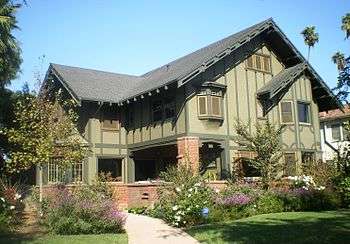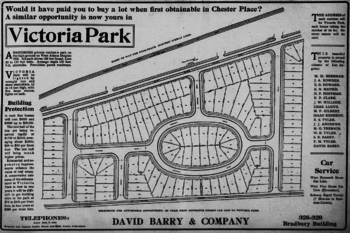Victoria Park, Los Angeles
Victoria Park is a mostly residential subdivision in the Mid-City neighborhood of Central Los Angeles, California.

.jpg)



Geography
Victoria Park is bounded by Pico Boulevard on the north, the rear lot lines of Victoria Avenue on the east, Venice Boulevard on the south and West Boulevard on the west. It is bisected by Victoria Park Drive.[2] It is 2.5 miles south of Hollywood and 3.5 miles west of downtown Los Angeles. Century City is five miles to the west along Pico Boulevard. The West Adams Heritage Association considers Victoria Park to be part of Historic West Adams.[3]
Lafayette Square and Wellington Square are just to the south. Windsor Square and Hancock Park are to the north.
History
Origin
A first mention of Victoria Park was on January 20, 1907, in the Los Angeles Sunday Herald:
A level, elevated block of around 1000x1000 feet, between Pico and Sixteenth streets, on the West Adams Heights hill, has been bought by a syndicate of a dozen prominent business men who will improve the tract as the highest class of residence property obtainable in the city. High class improvements are planned. Surface and subway car lines are close. David Barry & Co., the selling agents, say lots will range from $1720 to $2000 in value, corners higher.[4]
The platted but undeveloped tract was owned and offered for sale by a syndicate composed of Josias J. (Jerry) Andrews, David Barry, S.R. Barry, J.A. Bowden, E.P. Clark, H.P. Hoffman, E.G. Howard, M.P. Gilbert, Isaac Kennedy, Charles Lloyd, E.N. Mathis, J.W. Willcox, M.H. Sherman, M.O. Tremaine, B.S. Tyler, F.M. Tyler and W.E. Tyler.[1][5]
Established "as a "desirable residence tract for desirable people," the subdivision was limited to "high-class homes" that would be built for no less than $4,000. It would be "lighted by handsome stone and wrought-iron electroliers, twelve to fourteen feet high, with five large electric lights on each."
The Victoria Park neighborhood design is based on the ideas of Frederick Law Olmsted, who felt that "circular shapes broke up the linear look of most urban areas."[6] The area was intended to be upscale; for example, the streetlights were custom-designed and registered with the city as the "Victoria Park Fixture."[7]
Many of the homes were built between 1910 and 1915 and serve as fine architectural examples of the American Arts and Crafts Movement.
Drainage
Although the builders had promised in 1907 that Victoria Park, being "on a high hill," had "perfect drainage,"[8] property owners found two years later that rainwater was flooding down Pico Street from as far west as Vermont Avenue and turning into Victoria Park "with such volume that the street work has been torn up several times." After a complaint by property owner and police comissoner J.J. Andrews to the Board of Public Works, the city's chief public works inspector said he would look into the matter but he felt not much could be done unless the property owners would pave Pico at their own expense.[9]
Transportation
Streetcars were promised for both West 16th Street (today's Venice Boulevard) along the south boundary as well as a Pico Boulevard Line to the north. And by 1913, Pacific Electric's 16th Street Line would offer residents a 7 minute ride to downtown Los Angeles.[10] A few years later, in 1920, Los Angeles Railway's "P" Line (Pico Line) would finally reach Victoria Park. There was also a subway line promised to and from downtown.[1][8]
Hadacheck v. Sebastian
Victoria Park had a role in a landmark zoning case that reached all the way to the U.S. Supreme Court and was decided in 1915 as Hadacheck v. Sebastian. The court effectively ruled that the U.S. Constitution did not prohibit a local zoning ordinance from putting a commercial enterprise out of business.[11]
Security
In 1996, a pedestrian walkway between Venice Boulevard and Victoria Park Place was closed for security reasons. The $1,000 cost was borne by Victoria Park residents.[12]
Historic status
In 1998, the Craftsman home at 4318 Victoria Park Place (built in 1912 and pictured on this page) was added to the list of Los Angeles Historic-Cultural Monuments. In 2008, the Holmes-Shannon House at 4311 Victoria Park Drive (built in 1911 and also pictured here) was added to both the National Register of Historic Places and the list of Los Angeles Historic-Cultural Monuments; it is described as "a residential building designed in the Tudor-Craftsman style by a prominent firm and reflective of the development of Victoria Park."[6]
On December 2–3, 2006, the West Adams Heritage Association's twentieth annual Holiday Tour, titled "A Holiday to Remember in Victoria Park," took place in the neighborhood.[13]
On June 4, 2016, the West Adams Heritage Association sponsored a tour of 5 homes in Victoria Park. Titled "A Walk in the Park", the ticketed event was open to the public.[14]
Sugar Shack
The Sugar Shack is an "intentional community" occupying a two-story, three-bathroom house on the edge of Victoria Park that was brought to public attention through a feature story in the Los Angeles Times in April 2007.[15][16] Reporter Carla Hall wrote:
Sugar Shack is an oddity in this neighborhood, a home caught literally and figuratively between Pico [Boulevard] – with its fast-food joints and auto parts shops – and Victoria Park, a jewel-like hamlet a block south that is dotted with stately Craftsman houses.The homeowners of Victoria Park, which is diverse but mostly black, have a courtly sense of what a neighborhood should be, and it doesn't include a house that is painted blue and has a front door that looks like a piece of psychedelic art from a '70s head shop. The neighbors regard Sugar Shack . . . with some suspicion, unsure what the residents are up to and scornful of the house's exterior decor.[15]
At issue was a mural painted around 2005 by one of the Sugar Shack residents, artist Olga Socolovia, on the Pico Boulevard side of the property, just next to a bus stop,[17] without a city permit. Somebody complained, and residents of the house had to go to neighborhood meetings to explain what the community was all about and plead for support for their artwork. Some of the residents turned the meetings into a critique of the communal house itself, which sits in the commercially zoned Pico Boulevard strip of Victoria Park. In the end, the city granted a permit for the mural, which still exists. The Sugar Shack's front door has been repainted to blend with the neighborhood.[15]
Filming
A number of homes in Victoria Park have served as locations for feature films and tv shows, including the 1997 film L.A. Confidential,[18] the 2010 film Insidious,[19] and a 2014 episodes of Teen Wolf.[20]
See also
- List of Registered Historic Places in Los Angeles
- List of Los Angeles Historic-Cultural Monuments in South Los Angeles
Notes and references
Access to some of the links may require the use of a library card.
- 1 2 3 "Model Spanish Home in a Winterless City". Los Angeles Herald. (Los Angeles Calif.) 1900-1911. 26 May 1907. p. 1 – via chroniclingamerica.loc.gov.
- ↑ "Mid-city location of Victoria Park as noted on Mapping L.A.". L.A. Times.
- ↑ "Where Is West Adams? West Adams Heritage Association
- ↑ "Victoria Park," Los Angeles Herald, January 20, 1907, page IV-1
- ↑ "Palms and Drives Lend Air of Distinction to Victoria Park," Los Angeles Times, December 20, 1908, page V-24
- 1 2 "Holmes Shannon House" (PDF). Cultural Heritage Commission. Los Angeles Department of City Planning. June 12, 2007. Retrieved 25 May 2013.
- ↑ Virginia Comer (2000). Streetlights. Princeton Architectural Press. pp. 34–35. ISBN 978-1-890449-10-0. Retrieved 26 May 2013.
- 1 2 "Victoria Park to Be Exclusive," Los Angeles Times, October 23, 1907, page III-3
- ↑ "Victoria Park Is Often Flooded, Is Charge," Los Angeles Herald, November 18, 1909, page 10
- ↑ "Pacific Electric West 16th Street Line".
- ↑ Hadacheck v. Sebastian 239 U.S. 394 (1915)
- ↑ "Central Los Angeles: Council OKs Request to Close Walkway," Los Angeles Times, February 1, 1996
- ↑ "Progressive dinner holiday tour in Victoria Park". West Adams Heritage Association. Retrieved 26 May 2013.
- ↑ ""A Walk in the Park" -- a tour of Historic Victoria Park". West Adams Heritage Association.
- 1 2 3 Carla Hall, "The Cries of the Beholder," Los Angeles Times, April 12, 2007
- ↑ There is also a separate building, which is "a converted storefront with a full performance stage, pool table, as well as The Bus, a front half of a real school-bus that was installed into the wall and repurposed as a cozy hangout."
- ↑ View of Sugar Shack mural and bus stop
- ↑ "L.A. Confidential".
- ↑ Blog, Another Horror (11 July 2012). "The Location Scout: Insidious (2010)".
- ↑ GJW. "Teen Wolf Filming Locations: Sean's House".
Additional reading
- Kevin Herrera, "Victoria Park Circle Residents Face Off Over Historical Preservation Zone," Los Angeles Sentinel, September 19, 2002
Coordinates: 34°02′48″N 118°19′50″W / 34.0466°N 118.3305°W